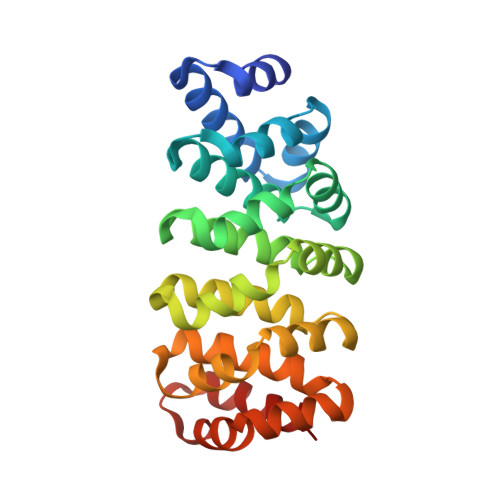Computationally Designed Armadillo Repeat Proteins for Modular Peptide Recognition.
Reichen, C., Forzani, C., Zhou, T., Parmeggiani, F., Fleishman, S.J., Mittl, P.R.E., Madhurantakam, C., Honegger, A., Ewald, C., Zerbe, O., Baker, D., Caflisch, A., Pluckthun, A.(2016) J Mol Biol 428: 4467
- PubMed: 27664438
- DOI: https://doi.org/10.1016/j.jmb.2016.09.012
- Primary Citation of Related Structures:
4D49, 4D4E - PubMed Abstract:
Armadillo repeat proteins (ArmRPs) recognize their target peptide in extended conformation and bind, in a first approximation, two residues per repeat. Thus, they may form the basis for building a modular system, in which each repeat is complementary to a piece of the target peptide. Accordingly, preselected repeats could be assembled into specific binding proteins on demand and thereby avoid the traditional generation of every new binding molecule by an independent selection from a library. Stacked armadillo repeats, each consisting of 42 aa arranged in three α-helices, build an elongated superhelical structure. Here, we analyzed the curvature variations in natural ArmRPs and identified a repeat pair from yeast importin-α as having the optimal curvature geometry that is complementary to a peptide over its whole length. We employed a symmetric in silico design to obtain a uniform sequence for a stackable repeat while maintaining the desired curvature geometry. Computationally designed ArmRPs (dArmRPs) had to be stabilized by mutations to remove regions of higher flexibility, which were identified by molecular dynamics simulations in explicit solvent. Using an N-capping repeat from the consensus-design approach, two different crystal structures of dArmRP were determined. Although the experimental structures of dArmRP deviated from the designed curvature, the insertion of the most conserved binding pockets of natural ArmRPs onto the surface of dArmRPs resulted in binders against the expected peptide with low nanomolar affinities, similar to the binders from the consensus-design series.
Organizational Affiliation:
Department of Biochemistry, University of Zurich, 8057 Zurich, Switzerland.
















